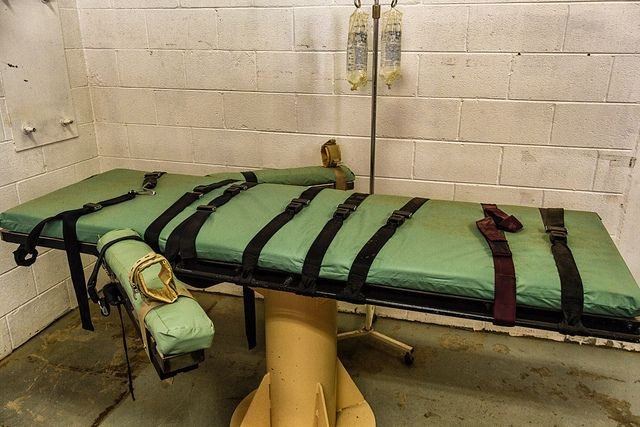Joseph Wood’s Execution Took Almost 2 Hours, As Lethal Injection Becomes America’s Latest Experiment

At 1:52 p.m. this past Wednesday, Joseph Wood’s veins became flooded with a cocktail of drugs intended to end his life. Wood was a convicted double murderer. The drugs entered his bloodstream and seemed to take effect, Wood appearing sedated and drowsy. But then a strange thing happened. He started snorting — a lot. His body began to writhe, like a fish out of water, according to one spectator. It wasn’t until 3:49 p.m., after nearly two hours of this behavior, that Wood was finally pronounced dead.
Lethal injections have made the news with troubling regularity in 2014. First there was the January execution of Oklahoma killer Michael Lee Wilson, who said, at one point, “I feel my whole body burning.” Then came the well-publicized April execution of Clayton Lockett. Fifteen years after Lockett ended his victim’s life, he met the same fate via lethal injection, but only after 40 minutes of restrained convulsing and the eventual heart attack. Today, Joseph Wood’s prolonged death reopens a still-healing wound in the United States. Medical science is as far forward as it’s ever been, so why are we so suddenly so bad at lethal injection?
"I've never witnessed an execution that took that long," Wood's federal public defender, Dale Baich, told NBC News after the ordeal had finally subsided. "The state of Arizona today conducted a failed experiment. ... It was horrible to watch."
Baich’s language is strong, but, all things considered, it seems accurate. Calling modern lethal injection an “experiment” isn’t hyperbole. The people selecting execution drugs don’t know what the drugs will do, and neither do the people administering them. The entire operation is based on the wait-and-see notion that inmates can’t report on their suffering if they are already dead, so any pain they feel they take with them to the grave. And so, the country moves on to its next guinea pig with the low-bar hope that death comes a few minutes earlier.
Execution, In Theory
Lethal injection emerged as a preferable means to kill murderers, over, say, death by hanging or a visit from the firing squad, because it was just as quick but involved none of the pain. When it was first conceived in its non-tortuous form in 1977, after being used as a grisly tool for euthanasia in Nazi Germany, people viewed it as the perfect way to keep capital punishment from becoming, as the Constitution mandates, cruel and unusual. This was a nice idea, in theory.
As a 2005 study shows, anesthesia turned out to be a big problem for lethal injection. More precisely, people who don’t know how to inject it or how much to inject of it turned out to be a big problem. The study found post-mortem concentrations of sodium thiopental, the go-to barbiturate to numb the pain of cell death, were lower than the required doses for surgery in 43 of the 49 inmates tested. Worse, prior to injection the team found “executioners had no anesthesia training, drugs were administered remotely with no monitoring for anesthesia, data were not recorded and no peer-review was done.”
The entire point of the anesthesia is, of course, to dull the sensation of the drugs that are actually lethal. Standard protocol dictates executioners lead with sodium thiopental, to induce unconsciousness, before giving the inmate a dose of pancuronium bromide, to paralyze the muscles and cease breathing, and potassium chloride to stop the heart. The whole thing should last no more than a few minutes.
So why did the deaths of Michael Lee Wilson, Clayton Lockett, and Joseph Wood take 25, 40, and just under 120 minutes to finally meet their ends?
Execution, In Practice
The answer, perhaps not so surprisingly, is politics. In 2011, the United States’ only manufacturer of sodium thiopental was a company by the name of Hospira. Seeking more lucrative markets for its drug production, Hospira set its sights on Rome, Italy. But the city’s government wasn’t keen on endorsing lethal injection with sodium thiopental, if only indirectly, by doing business with an American company who also supplied the nation’s prisons with the stuff. Rome balked, and the deal stalled. And Hospira, feeling pressure from oppositional forces both stateside and in Italy, cut its ties with U.S.
"We cannot take the risk that we will be held liable by the Italian authorities if the product is diverted for use in capital punishment," the company said at the time.
The decision sent the U.S. correctional system scrambling. And it’s a problem the country still hasn’t resolved. Without sodium thiopental, other drugs are getting called in to take its place, whether they’ve been lab-tested as safe and effective or not. Inmates have become the lab rats, their wails and cries nothing but tiny wrinkles in the slow, gruesome march toward finding sodium thiopental’s understudy.
During his near two-hour grappling match with death, Wood reportedly gasped more than 600 times. In final moments like those, when you are watching someone of your own species squirm like a dried-out fish, traces of humanity must emerge at some point, if only for a flash, where you are reminded that even murderers were treated as people in the eyes of the country’s founders. Cruelty has no place in justice, they warned, even if the problems they intended to prevent wouldn’t be invented for another 200 years.
"At a certain point,” reporter Troy Hayden said to NBC News’ Tracy Connor after Wood’s inevitable submission, “you wondered if he ever was going to die."
Published by Medicaldaily.com



























